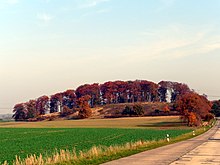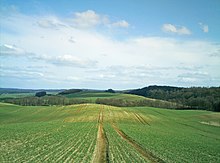Terminal moraine

A terminal moraine or frontal moraine is a wall-like embankment ( moraine ) of rock material at the end of a glacial inland ice or a glacier . A terminal moraine marks the line of maximum glacier advance or a glacier standstill. It is part of the glacial series .
Emergence
Terminal moraines are created when the end of a glacier melts and the supply of ice is balanced. The ice edge then remains stable for a long time; but the ice itself is still moving.
Since the edge of the ice is not straight, but rather breaks up into individual lobes ( glacier tongues ), terminal moraines also have such a lobed course. (For the term glacier globe see foreland glacier .) The point of contact between two lobes is also called the terminal moraine fork. There are mostly particularly strong terminal moraines and large glacier gates from which the sand was poured.
Set end moraines
Material that melts from the glacier is deposited on the edge of the ice and gradually builds up the terminal moraine as a set terminal moraine. Fine material is mostly washed away by the escaping meltwater, so that the deposits of set end moraines are usually coarse ( gravel , stones , boulders ). In between, however, there is also finer material ( sand ) or glacial till . Very coarse terminal moraine material is known as block packing. Material deposited in the forehead area of a glacier tongue usually forms terminal moraines.
Compression moraines and compression moraines
Smaller upsetting moraines arise when older material that was deposited in front of the glacier front comes under horizontal and vertical pressure due to the pressure of an advancing glacier and is compressed and thrown up in the process. Depending on the nature of the older material, these compression moraines consist of a wide variety of sediments. Most of them are older glacial deposits such as sand , Ice Lake sediments or older glacial till . However, the compression of the subsoil is not tied to the ice edge and thus to an end moraine. Even below an active glacier, within the later ground moraine landscape, material can be severely disturbed by the pressure exerted. Sometimes the neutral term compression moraine is used for all these different types of compression.
Arctic compression moraines
Another order of magnitude with a different formation mechanism is shown by compression moraines, which are characterized by very high relief energy . They were created in the Ice Age climate of Central Europe when polar glaciers penetrated the permafrost soil, which was several hundred meters thick at the time . Large frozen sediment packages can be stacked on top of each other at a height of up to 100 m. In geomorphology , the term glacial tectonics is used for this. Old moraines with high relief energy can be found in large numbers in Poland and northern Germany . Radar measurements in old moraines can show that the subsurface of these hills consists of very large, crooked blocks, evidence of the formation described under permafrost conditions. In the Netherlands, the up to 110 m high ridge of the Veluwe is a well-studied old moraine area.
Arctic compression moraines are still numerous today in the glaciated permafrost areas of the Nunavut Territory of the Canadian High Arctic . Sixteen arctic compression moraines have been described on Ellesmere Island alone , and another nineteen on Axel Heiberg Island . The formation of large arctic compression moraines could be observed and measured here over decades. When advancing large ice caps or polar glaciers, frozen sediment packages of the compression moraine several hundred meters wide and kilometers long can be displaced horizontally as a whole through the advancing ice.
Ice edge layers
Since the terminal moraine consistently have gaps, especially in northern Central Europe, the term ice edge layer has become established in technical terminology , which includes both terminal moraines and other land forms from which the former ice edge can be reconstructed.
Examples
Northern Germany
An example of a terminal moraine landscape from the Glaciation of the Vistula is located near Chorin in Brandenburg . The East Hanoverian terminal moraine of the Saale Glaciation extends between Drawehn in the Lüneburg Heath and Göhrde in Wendland . Another relic of the Saale Glaciation is the Ankumer Höhe in the Osnabrück district . That ice edge location was called the Rehburg phase here . Many terminal moraines shape the North German lowlands . In Schleswig-Holstein and Mecklenburg-Western Pomerania , Ahrensbök , Kiel and Strasburg (Uckermark) provide striking examples.
Prealps
The entire transition area from the Alps to the Alpine foothills is characterized by the marginal moraines of the large glacier advances. In Otterfing south of Munich is well-trained moraines place. The Hausruck in Upper Austria, a striking range of hills, is the 400 m high terminal moraine of the Hallstatt Glacier in its greatest extent.
An impressive example of high alpine terminal moraines can be found at the end of the Forno Glacier in Graubünden.
See also
Individual evidence
- ↑ Van der Wateren, Dick M .: Processes of glaciotectonism. - In: J. Menzies, Modern and Past Glacial Environments, pp. 417-443, 2002. https://www.sciencedirect.com/book/9780750642262/modern-and-past-glacial-environments
- ↑ Bakker, MAJ and Van der Meer, JJM: Strukture of a Pleistocene push moraine revealed by GPR: the eastern Veluwe Ridge, The Netherlands. - In: CSBristow and HMJol (eds.), Ground Penetrating Radar in Sediments, Geological Society, London, Special Publications 211, pp. 143–151, 2003.
- ^ Kälin, M .: The active push moraine of the Thompson Glacier, Axel Heiberg Island, Canadian Arctic Archipelago. - Axel Heiberg Island Research Reports, McGill University, Montreal. Glaciology No. 4, 68 pages, 1971.
- ^ Lehmann, R .: Arctic push moraines, a case study of the Thompson Glacier Moraine, Axel Heiberg Island, NWT, Canada. - Zs. For Geomorphology NF, Suppl.-Vol. 86, pp. 161-171, 1992.
- ↑ Hell, G .: Geodetic and photogrammetric work on Oobloyah Bay, N-Ellesmere Island, NWT, Canada, as part of the Heidelberg Ellesmere Island Expedition 1978. - Heidelberger Geographische Arbeit 69, pp. 35–46, 1981. ISBN 3- 88570-069-7 .
- ^ Rehburg phase



